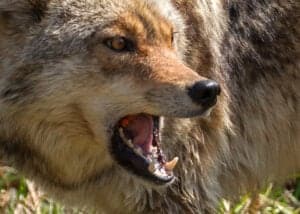Where would you expect to encounter a coyote? In the mountains of Idaho? In the deserts of New Mexico? Yes, but don’t be surprised if you also spot one on your video doorbell, no matter where in North America you live. The range of coyotes now extends from Alaska and Canada to Mexico, along with all the U.S. states, with the exclusion of Hawaii. These wild cousins of wolves and domestic dogs are no stranger to Massachusetts. Coyotes are found in every part of the state: rural, suburban, and urban, with only Nantucket and Martha’s Vineyard remaining coyote-free. In this article, we’ll learn more about coyotes in Massachusetts, including their population, behaviors, and rules about hunting them.
Coyotes in Massachusetts Are BIG
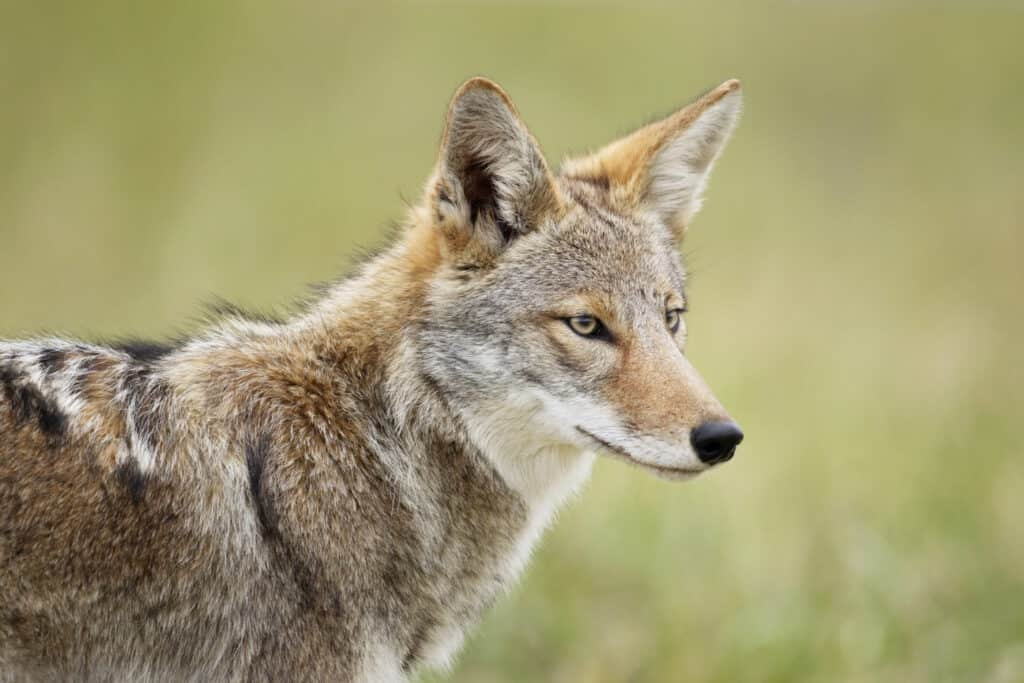
Eastern coyotes are larger and have more variegated color patterns than western coyotes.
©Paul Tessier/Shutterstock.com
In all, there are about 12,000 coyotes in Massachusetts. They’re noticeably bigger in the Eastern United States than in the West. Eastern coyotes weigh up to 50 pounds compared to 30 pounds for the western variety. They also have odd color combinations of red, black, and pale brown shades. All of this, genetic researchers tell us, is because eastern coyotes are mating with wolves and domestic dogs, producing “coydog” hybrids. How worried should you be if you live in this East Coast state? Well, in the past 60 years, there have been reports of only 10 attacks of coyotes on people. However, if their numbers expand and their size continues increasing, attacks could become more frequent and more deadly in the future. This is one reason it is important to control the coyote population.

Meet the Wiley Coyote
Can a Coyote Catch a Roadrunner?
In the old Looney Tunes animations, Wile E. Coyote could never quite catch that speedy roadrunner, no matter how much dynamite he used. In real life, coyotes can reach speeds of 43 mph while the best a pokey roadrunner can manage is 26 mph! Coyotes quite regularly feast on roadrunners in the parts of the country where they are available. More often, though, they eat small mammals like mice, rats, rabbits, raccoons, and squirrels as well as carrion. They’re not averse to snatching small dogs and cats, either. They are omnivorous, so they enjoy a little salad, too: corn and other grains, fruits, and vegetables. So, the coyote is a critter that will raid your garden, your henhouse, AND your doghouse.
What Do Coyotes Look Like?
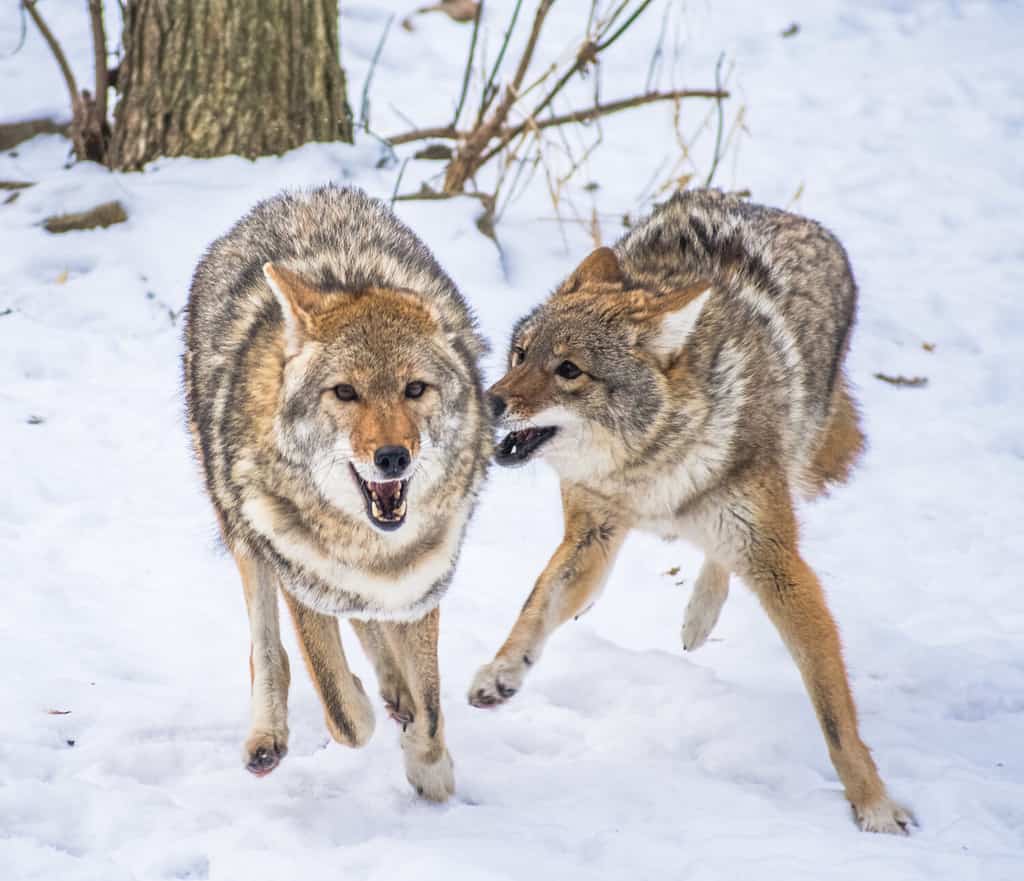
Coyotes look a bit like wolves but are smaller. They stand about 2 feet tall at the shoulder and weigh only 20-50 pounds. That’s about the size of an Australian shepherd. Measured from nose to tail, they can be 3.3-4.3 feet long. Their coarse fur looks grey, brown on the back, and white on the belly. Their legs are often a reddish shade, and their tails are bushy with black tips like they’ve been dipped in paint.
What Do Coyotes Do?

Coyotes hunt in a variety of ways: alone, in pairs, or as part of a pack. Working together is more effective, but even a single coyote can bring down a deer or other much larger animal by harassing it and nipping at its legs and hindquarters to inflict bleeding wounds. As the animal loses blood and weakens, the predator is able to go for the jugular to make its kill. They are opportunists who look for the easiest way to get a meal, even if that’s roadkill from the highway or a tipped-over garbage can in front of your house. Of course, if you leave a bowl of uneaten dog food out overnight, you’re pretty much inviting all sorts of critters to your yard, including coyotes.
The most tell-tale way you can know there are coyotes in the vicinity is to listen for them at night howling, barking, and yipping at each other. Hopefully, you’re safe at home in your bed, and not sleeping in a tent with nothing but a thin layer of fabric to protect you.
What’s Good About Coyotes in Massachusetts?
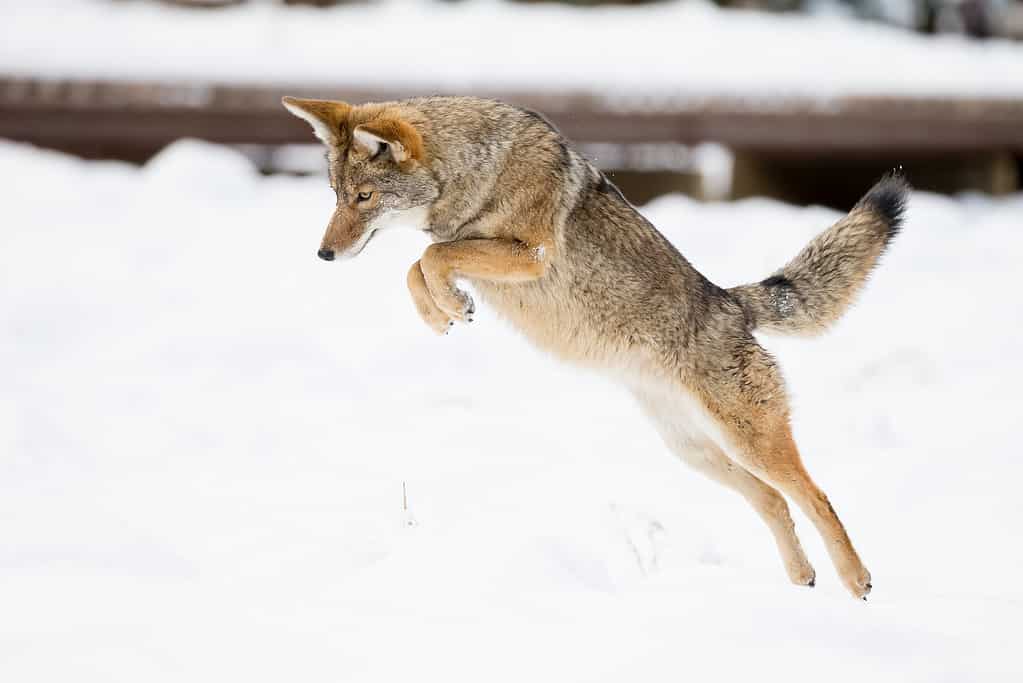
It’s not necessarily a bad thing to have coyotes around your neighborhood. After all, they regularly dispatch mice, rats, skunks, opossums, raccoons, foxes, rabbits, and reptiles, and they clean up animal carcasses left by the side of the road or in the forest. They also help control feral cats. Believe it or not, cats are one of the most damaging invasive species on the continent! They number over 70 million and do tremendous damage to bird species. Because coyotes are looking for the easiest meal possible, they tend to stay away from people unless they are extraordinarily hungry and become desperate.
What’s Not So Good About Coyotes in Massachusetts?
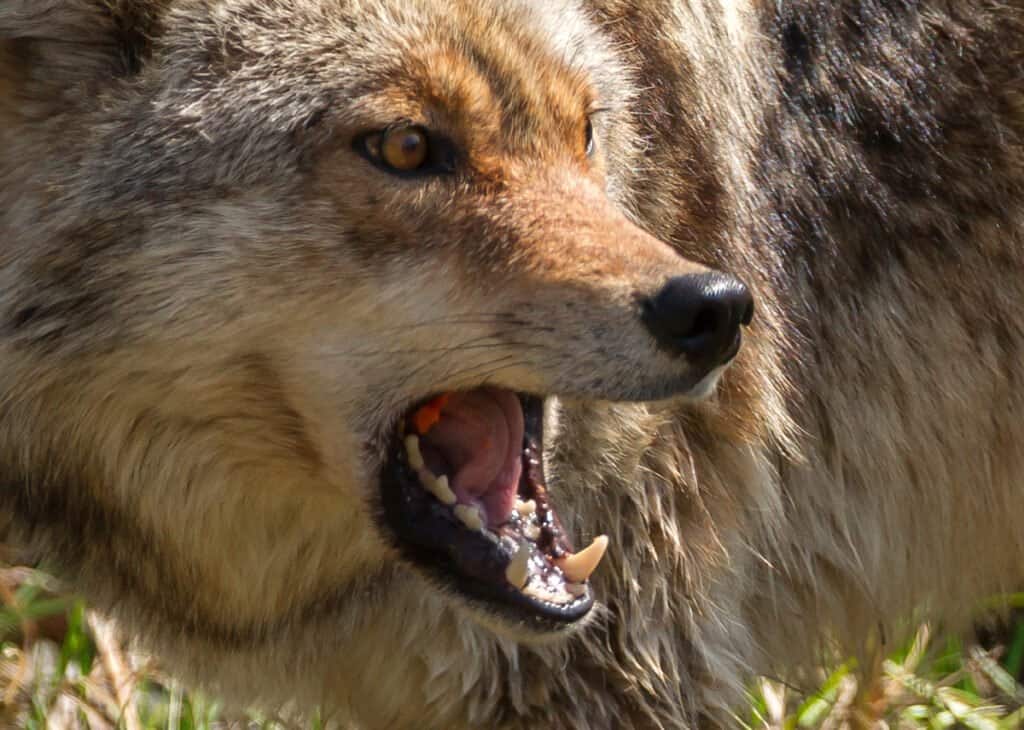
Yes, coyotes kill pest species and keep wild animal populations down, but they also kill domestic pets such as cats, dogs, and small livestock. They carry diseases that can infect domestic dogs. They can impregnate pet dogs as well, leaving you with half-wild coydogs to deal with, if you have not had your female dog properly spayed. Scavenging for roadkill, they can become roadkill themselves, creating a hazard for drivers, especially at night.
Humans can also make the problem worse. For example, if people feed them or they are allowed to raid garbage cans and dumpsters without challenge, they can become bolder and bolder about approaching people. Some people might mistake them for dogs and get too close for safety or try to scare them off without a weapon and find the animal stands its ground and attacks when they get too close. A fearless coyote might even try to take a pet from a yard with people a mere feet away.
The Pros and Cons of Hunting Coyotes
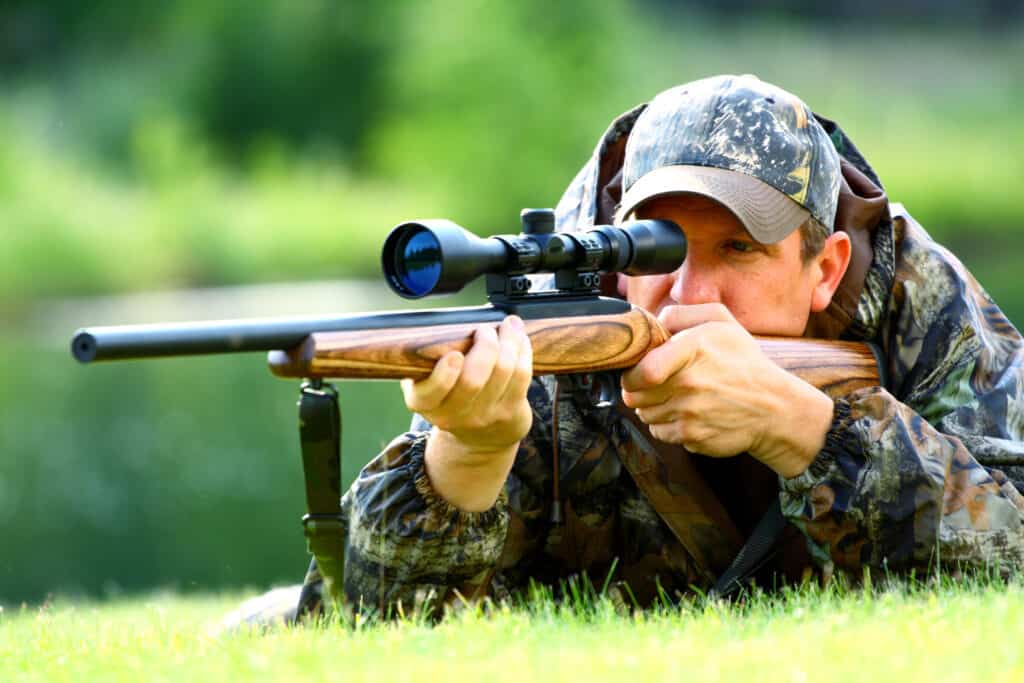
The Pros of Hunting Coyotes
Those who are in favor of hunting in general, including coyote hunting in particular, point out that it can be part of a strategy to control animal populations in a more humane way than what nature would do on its own. If people had not destroyed the populations of wolves, bears, or mountain lions, these animals would reduce the coyote population. But because humans have eliminated these dangerous large carnivores near populated areas, coyotes have no natural predators in many of their habitats.
Humans, the apex predators of all predators, have to step in to maintain ecological balance. An overpopulation would deplete prey species, eventually leading to disease and starvation in the bloated coyote population. Sick and hungry packs of coyotes would be far more dangerous to people and domestic animals. Hunting can keep their numbers down so the remaining coyotes stay healthy, wild, and well-fed in their environmental niche.
The Cons of Hunting Coyotes
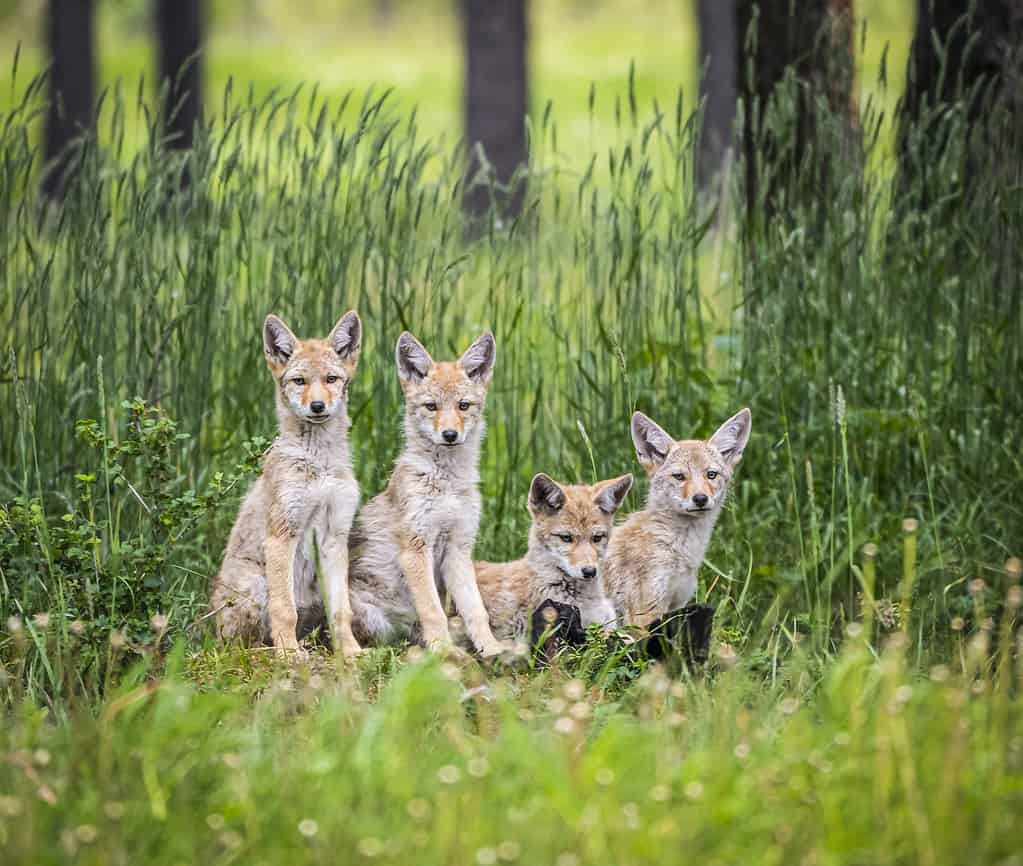
For reasons not understood, excessive hunting can lead to higher birth rates among surviving coyotes.
©Annie Hewitt/iStock via Getty Images
Hunting is a controversial topic for those who love animals. It is not clear that hunting lives up to the hype of controlling animal populations. Some studies have shown, for example, that hunting coyotes, for some reason, can cause them to have a higher birth rate. Observation of wild boar behavior shows that hunting can change the animal’s feeding patterns and scatter them into new habitats. One of the biggest problems with allowing hunting is that hunters themselves may illegally introduce a species into a new environment to create a local hunting stock for themselves. This is a part of the reason that both wild boars and coyotes are so widely dispersed in the country today. No doubt a combination of strategies, lethal and non-lethal, are necessary to deal with this multi-faceted problem.
Hunting Coyotes in Massachusetts

Laws For Hunting Coyotes
The coyote hunting season in Massachusetts starts on the first Saturday after Columbus Day and extends through March 8th of the following year. Hunting hours start 30 minutes before sunrise and end at midnight, except during shotgun deer season when hunting hours end 30 minutes after sunset. Massachusetts residents must have a hunting or sporting license, while people from out of state need a small game or big game license. There are no bag limits. Trapping is permitted for hunters 12 or more years old, with a trapping license.
Hunters can use shotguns, rifles, handguns, muzzleloaders, and archery equipment, all with certain regulations. Decoys and bait can be used anytime during the season. Electronic or manual calls and dogs are permitted only outside of shotgun deer season. Artificial lights are prohibited for coyote hunting in the state. Hunters must also remove their kills from the forest and make some use of them, such as retrieving the pelt or using the animal for taxidermy. Kills must be reported within 48 hours to an official check station or online and a confirmation number must be affixed to the animal until it is prepared for mounting, tanned, or sold to someone else.
When and Where is Best to Hunt Coyotes in Massachusetts?

Every year, three to four coyote sightings in downtown Boston are reported to authorities.
©bwzenith/iStock via Getty Images
Approximately 500 coyotes a year are killed in Massachusetts. Hunters do not always set out specifically to bag a coyote. Many of them shoot one opportunistically in hunting season while waiting for deer in a blind. Coyotes hunt nocturnally, so evening and morning are productive times to hunt them as they leave and return to their dens. They like making their homes near creeks and swampy land where they can find plenty of small prey drawn to the water source and aquatic life. In the winter coyotes are hungrier and will respond better to calls that they might have ignored in more abundant times of the year.
Hunting enthusiasts suggest these as some of the best coyote hunting spots in the state:
- Blue Hills Reservation, just outside Boston
- Wompatuck State Park, Hingham
- The towns of Plymouth and Marshfield
- Quabbin Reservoir
- Wachusett Mountain State Reservation, Princeton
- Rutland State Park
- Mount Greylock State Reservation
- Berkshire East Ski Area (in the off-season)
Coyotes Are Not Going Anywhere Soon

Coyotes call us back to our own wild roots.
©sebartz/Shutterstock.com
All too often, animal stories concern the sad tales of endangered species with uphill fights to hold their own against human encroachment. In contrast, the coyote is an overwhelming success story. It’s a species that has learned to adapt to the highly modified and often unnatural environment human beings have created. To the extent that coyote numbers remain manageable, they will continue to roam our farms, towns, and cities. And as we hear coyotes howling at the moon, we are reminded that no matter how modern we become, we are creatures of the wild, too.
The photo featured at the top of this post is © Dennis Laughlin/Shutterstock.com
Thank you for reading! Have some feedback for us? Contact the AZ Animals editorial team.





